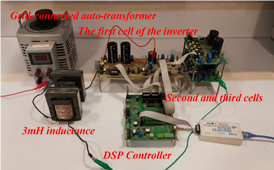
02161115044

Due to increased number of switches in multilevel converters the possibility of failure is more. To avoid further damages the uninterruptable operation of converter, fault detection and localization and fault-tolerant operation are vital. In this project, a fault detection and localization method, and a method for fault-tolerant operation of CHB converters are proposed.
The fault occurrence will be recognized by observing difference between the reference voltage and the output phase voltage. Hence, one voltage sensor and one current sensor are needed per phase which are the least possible number of sensors. The switching method will be changed during the fault localization to generate reference voltage in the output in addition to guarantee identifying the fault location as quickly as possible, independent from modulation technique and modulation index. The validation of proposed method has been proved by simulation and experimental results.
A fault-tolerant operation method is presented, which generates the maximum line to line voltage after the fault, same as the normal condition. In this method an auxiliary module, which is made by six semiconductor switches and one capacitor, is added to converter. Compared to other methods that need additional devices, the proposed method requires less devices and in consequence less cost while the maximum output voltage is same as normal condition. By implementation of this method, both in simulation and experiments, the validity of method have been confirmed.

Power Electronics and Energy Systems Laboratory was established in 2010 with the aim of training efficient engineers and researchers. In this educational and research environment, specialized fields such as the design of power electronic systems, including all types of power supplies, inverters and rectifiers, high and multi-level power converters, types of high voltage or HV systems, energy conversion systems, etc. are under study and research.

Design: Mahyan
Leave a Reply